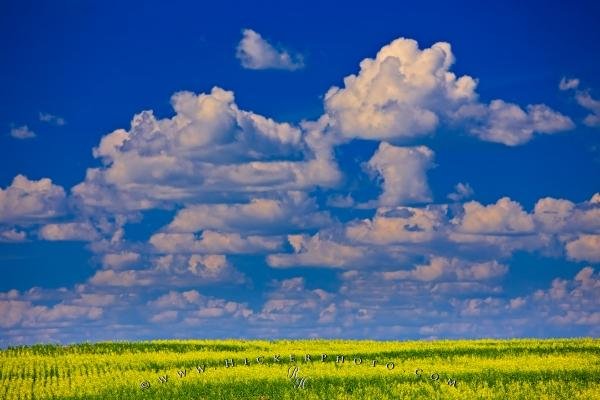Photo: Canola Crop Qu Appelle Valley Saskatchewan Canada
A bright yellow field of Canola grows tall in the Qu'Appelle Valley, which is actually considered a 'valley of legend' in Saskatchewan. The seeds of this crop is used to produce oil that is common in most people's kitchens as a cooking oil.
Canola, that is used to make cooking oil and feed for livestock, was originally bred from rapeseed in Canada in the early part of the 1970s. The name actually comes from the phrase 'Canadian oil, low acid', and at one time this used to be a staple cash crop for Canada, but now has become one for all of North America. Seven to ten million tonnes of canola seed is produced each year in North America, and Canada exports about three to four million tonnes of seed. It also exports about 700,000 tonnes of actual canola oil as well.
Most of the seed is shipped to Japan, Mexico, China and Pakistan, and the oil is mostly shipped to areas of the United States. It wasn't until 1974 that Dr. Baldur Stefansson used a process of selective breeding for rapeseed to develop a stable variety that was low in erucic acid, and hence, canola was born. Using gene splicing in 1998 resulted in a type of canola that is considered to be the most disease and drought resistant variety that exists today. ... continue below the picture...
Canola Crop Qu Appelle Valley Saskatchewan Canada

Pictures from photo gallery "Canon Eos 7d Mark Ii"
This picture is part of the photo album "Saskatchewan Pictures" - there are more beautiful images waiting for you.
Related stock photo galleries, pictures & travel ideas:
Canola Crop Qu Appelle Valley Saskatchewan Canada
... The oil produced by this seed is considered low in saturated fats and high in monounsaturated fats and therefore has a number of health benefits.
The area where this is grown is not only good for growing crops but is also a popular destination for tourists and visitors as it contains many campgrounds and areas to relax in and enjoy the great outdoors.
Field of Canola in the Qu'Appelle Valley, Saskatchewan, Canada.
Technical Information:
I photographed this photo with the digital SLR camera model Canon EOS-1Ds Mark III, aperture of f/5.6, exposure time of 1/320 sec. on ISO 100, as always I used a original Canon Lens, the focus lenght for this picture was 200mm.
A bright yellow field of Canola grows tall in the Qu'Appelle Valley, which is actually considered a 'valley of legend' in Saskatchewan. The seeds of this crop is used to produce oil that is common in most people's kitchens as a cooking oil.
